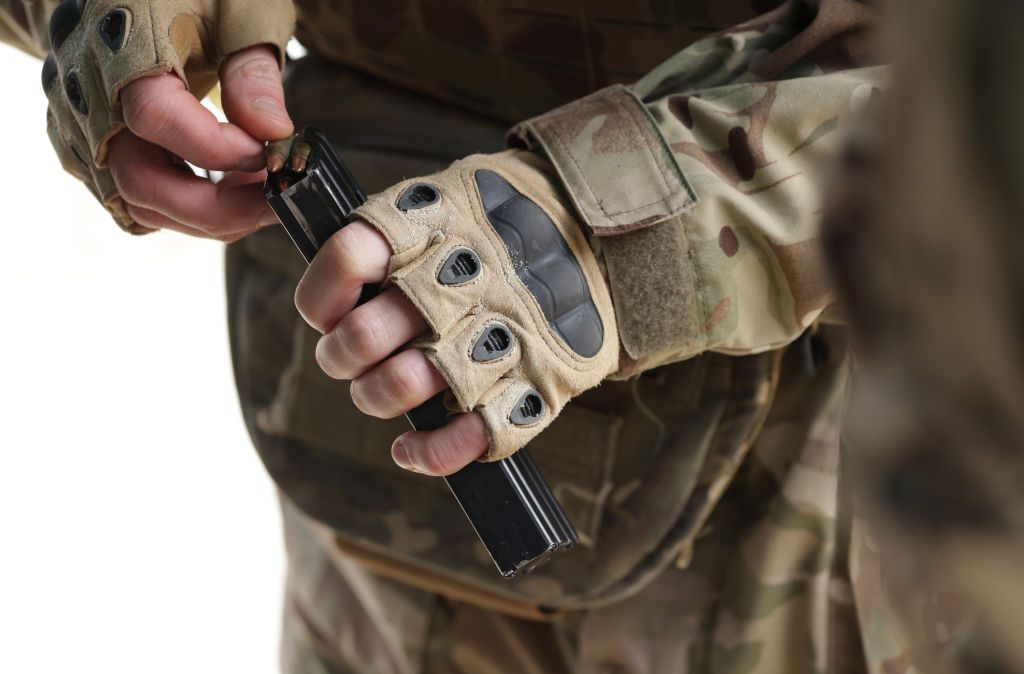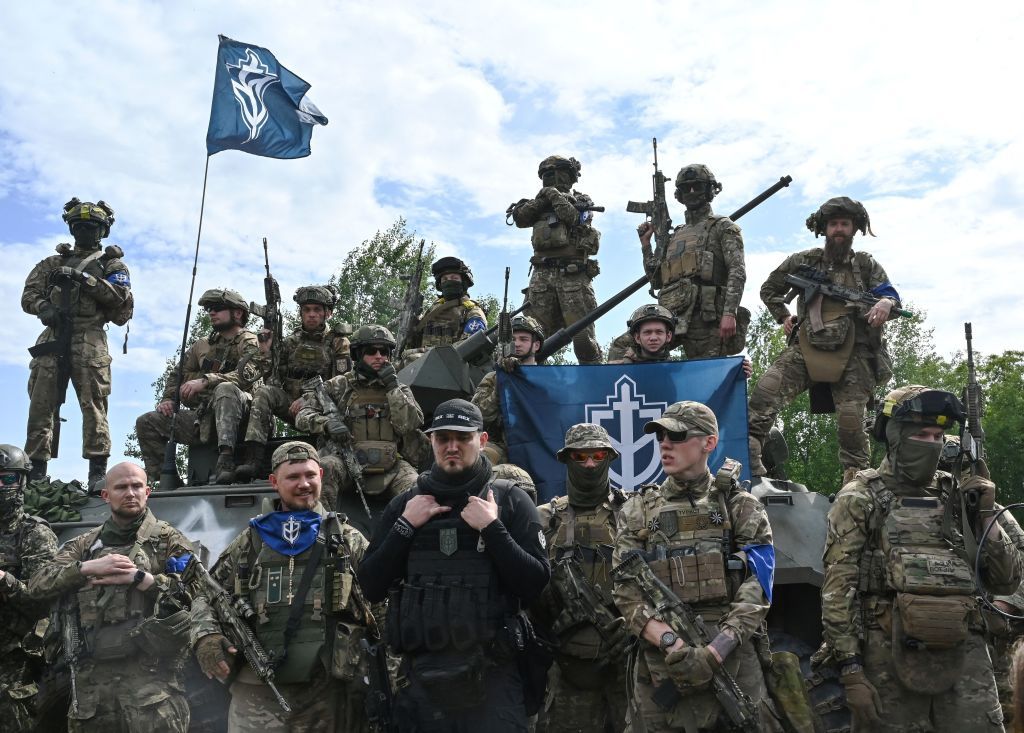
You're closely following the living history of a nation bravely resisting an imperialistic war of aggression that has inspired the world when, all of a sudden, you come across a picture of a Ukrainian soldier wearing a Totenkopf "skull and crossbones" patch or giving the Nazi salute.
Rightfully so, the use of Nazi or neo-Nazi-related symbols by Ukrainian combatants is shocking and almost always causes controversy.
These symbols, reminders of some of history's worst crimes against humanity and the attempt to exterminate entire groups of people, are deeply offensive.
Of course, seeing these symbols on soldiers is always distressing, to say the least. While these soldiers do not represent a widespread practice in the Ukrainian military, the use of these symbols nonetheless discredits Ukraine and scares away some potential supporters worldwide.
After almost a decade of reporting on this war, I'd like to chip in with a couple of thoughts on why you might see these symbols on the battlefield in Ukraine. Not to justify these soldiers' decisions — as any use of Nazi symbols should always be condemned — but to offer my explanation for this phenomenon.
So, why are these symbols present on the battlefield?
First of all, let's establish one fact. No, Ukraine does not have "a Nazi problem."
Ukraine is no more "Nazi" than any country that has its small number of misfits who admire Adolf Hitler and form fringe groups and gangs based on those views. Ukraine has its groups like the U.K. has the neo-Nazi organization Combat 18, the Scandinavians have the Nordic Resistance Movement, and the United States has the Aryan Brotherhood.
With absolutely no proof, the Kremlin's war propaganda created the absurd narrative that Ukraine is a full-fledged, World War II-style Nazi nation that needs to be "de-Nazified" as justification for its brutal full-scale invasion of Ukraine.
Just like in many places around the world, people with far-right and neo-Nazi views, driven by their ideology, are prone to joining the military and participating in conflicts. One also has to take into account that in Ukraine, nationalism with deep historical roots is tied to a desire for independence from Russia. It has driven many to take up arms to fight in what they believe is an existential war against a neighbor that seeks to subjugate and destroy their country.
Among them, people with far-right views.
This feeling was very real back in 2014, in the early days of Russia's war in Ukraine's eastern Donbas. Ukraine's military was deeply disorganized and disoriented. Ultra-nationalist and far-right groups were among the many others that organized volunteer battalions to fight Russia's invasion in the east.
These groups were aggressive and highly motivated. It is, of course, true that, for instance, the Azov Battalion was originally founded by neo-Nazi and far-right groups (as well as many soccer ultra-fans), which brought along with it the typical aesthetics — not only neo-Nazi insignia but also things like Pagan rituals or names like "The Black Corps," the official newspaper of Nazi Germany's major paramilitary organization Schutzstaffel (SS).
But as with any country, real neo-Nazis in Ukraine were and still are a tiny minority.
All former guerilla groups with far-right ties were quickly absorbed into Ukraine's Armed Forces or the National Guard between 2015-2016 as linear, disciplined, and fully-controlled combat units.
From my experience observing this war over the years since 2014, the Ukrainian military has done a rather good job of "secularizing" and isolating these units from their far-right origins, largely due to pressure from the West.
This policy could be described as "keep your views to yourself and train hard."
This is what happened with Azov. Far more moderate servicemembers rose to prominence (and even to fame during the Battle of Mariupol and the siege of Azovstal), along with military specialists from other branches of service, who joined Azov because they wanted to serve with a highly professional combat unit.
It hasn't helped that, since 2014, some Western journalists have made the supposed "rise of the far right" a staple of their coverage of Ukraine, as headlines of supposed neo-Nazis in the country are consistently attention-grabbing.
And right before the full-scale invasion, certain American journalists wrote about how Ukrainian neo-Nazis were allegedly using the threat of Russia's full-scale invasion to seize power in the country.
But guess what — the Russian invasion did happen, and the neo-Nazi power grab never did. Not only was there no serious evidence ever presented to support claims of an attempted "coup," these fringe elements are nothing compared to Ukraine's state and military machine.
A drop in the ocean, as the saying goes.
Nevertheless, notorious Nazi and quasi-Nazi symbols are sometimes used by soldiers who do not come close to having any extremist or hateful views.
So why is this happening? In the oversimplified memory of some around the world, particularly within various militaristic subcultures, symbols representing the Wehrmacht, Nazi Germany's Armed Forces, and the SS are seen to reflect a super-effective war machine, not the perpetrators of one of the greatest crimes against humanity in human history.
While this, of course, does not absolve these soldiers of wearing extremely offensive insignia, it offers a partial explanation as to why, in my opinion, these symbols have become an integral part of global militaristic subcultures that embrace different historical symbols of war, particularly Nazi ones.
As these insignia were absorbed into militaristic subcultures around the globe, many who wear Nazi patches on their uniforms have come to disassociate these emblems from the crimes committed by their original users 80 years ago.
Although the presence of Nazi symbols on the battlefield generates the most controversy, they are just a fraction of the militaristic emblems embraced by combatants worldwide. Norse and pseudo-Norse, or Viking, symbols of war — the very symbols that the Nazis themselves used to create their own insignia — are also very common.
The culture of modern war patches, a strange, pseudo-art form in militaristic subcultures, has developed into a standalone phenomenon in which those who bear them sometimes completely divorce their modern use with any former ideology. And some symbols hardly have any ideology behind them at all – such as the ubiquitous Punisher skull patch coming from the famous Marvel show.
 The Kyiv IndependentAsami Terajima
The Kyiv IndependentAsami Terajima
This phenomenon is hardly unique to Ukraine.
One might remember a scandal over the fact that U.S. Marines Scout Snipers used the SS runes as their unofficial symbol. In 2012, they thought it was a good idea to take a picture of themselves posing next to an SS flag in Afghanistan, prompting swift action from the Corps.
Russia's propaganda created and cultivated for years the myth about the Ukrainian far-right, inflating their numbers and so-called power within the country. Many Western journalists have built their entire careers feeding off of Moscow's narrative.
The irony is that Russia has long promoted not only Nazi-style symbols but Nazi practices, morphing into a fascist state that has made war crimes part of its foreign policy.
The Russian far-right and neo-Nazi paramilitary unit Rusich uses both the swastika and the 88 symbol, a neo-Nazi numerical code for "Heil Hitler."
Dmitriy Utkin, the alleged co-founder and top commander of the notorious mercenary army Wagner Group, has a large swastika and the Wehrmacht symbol tattooed on his body. And yes, he goes under the nom-de-guerre Wagner not because he's a big fan of the opera. Hitler was a great admirer of the 19th-century German composer Richard Wagner and glorified him during his reign.
Russia's official policy is ethnic cleansing, killing those speaking Ukrainian, kidnapping Ukrainian children and raising them as Russian, and denying a nation of 40 million the right to exist.
For some Ukrainians, the use of some of these symbols is meant to overtly demonstrate a fierce opposition to Russia – which, for its part, is insanely obsessed with the aggressive weaponization of everything about the Soviet Union's role in World War II, which Russian propaganda portrays as largely a Soviet defeat of the Nazis and fascism.
So yes, while Nazi symbols are not widespread within Ukraine's military, it is still a difficult issue that needs to be resolved.
If I were in charge of such things, I'd enforce severe punitive action for wearing Nazi-related insignia. Nazi symbols do not deserve to be on a Ukrainian soldier's shoulder in this war, where Ukraine is fighting for the very fundamental values the free democratic world is built on.
A military has all kinds of people — and Ukraine's is a very large one. With all of its branches, Ukraine's Defense Force now has some 1 million people in ranks.
And problematic pictures of those who think it's "cool" to wear Nazi-related insignia represent nothing but the attitudes of a select few – not the entirety of this military and, least of all, of this nation.
Note from the author:
Hello! My name is Illia Ponomarenko, the guy who wrote this piece for you.
I hope you found it useful and interesting. I work day and night to bring you quality stories from Ukraine, where Russia is waging the biggest war in Europe since WWII. My little homeland, Donbas, is now the site of the worst fighting. We are helping to keep the world informed about Russian aggression.
But I also need help from every one of you — to support Ukrainian wartime journalism by donating to the Kyiv Independent and becoming our patron.
Together, we can help bring peace to Ukraine.
Comments
No comments yet. Be the first to react!